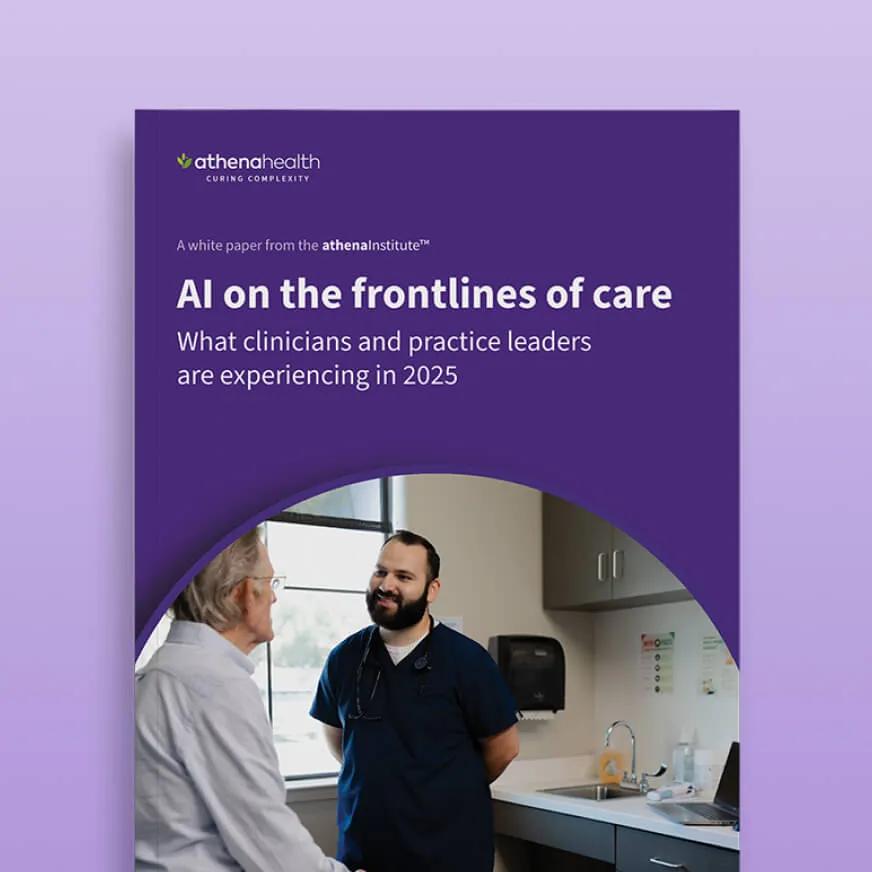Tapping into artificial intelligence’s real benefits for clinicians and patients
Although physician burnout decreased after reaching all-time highs during the pandemic, many clinicians still feel overwhelmed by administrative requirements and burdens. Some report spending an additional 15 hours per week working outside normal business hours.1 These critical findings come from athenahealth’s Physician Sentiment Survey conducted by The Harris Poll to examine the factors impacting physicians’ experiences. The survey of more than 1,000 physicians revealed pervasive feelings of burnout and dissatisfaction, but also an increasing sense of optimism about the possibility of AI in healthcare improving the administrative burdens so often at the root.
Some of the healthcare industry’s biggest challenges today are centered on a lack of resources needed to make a practice run. Turnover rates are high, there’s a shortage of labor, and the remaining physicians at hospitals and medical offices across the U.S. are faced with overwhelming amounts of work. Many healthcare workers across the country are disillusioned with the state of healthcare, and many believe that we’ve already hit a breaking point.
But what if technology – including AI agents – could help reduce some of this burden? What if automation and intuitive machine learning could take administrative work off physicians’ plates, allowing them more time in their day and focus on patient care, instead of documentation and administration?
The answer? The right technology already is.
Advancements in artificial intelligence can strengthen doctor-patient relationships by reducing time spent on admin work, notetaking, and claim resolution. Building an AI-native intelligence layer on top of the foundational data background driving an EHR spearheads moving toward a truly AI-native electronic health record (EHR). This AI-native EHR operates as a single, intelligent system that helps practices tap into the true potential of AI in healthcare to lessen cognitive burden and most importantly, improve patient and practice health.
Let’s take a closer look at how AI-native EHRs can help transform the state of healthcare today, including where AI fits in the broader ecosystem.
New technology is helping solve the right problems with AI
Many physicians believe that AI has the potential to help solve this burnout epidemic in the U.S. Over a quarter (26%) of physicians surveyed think AI may help to reduce physician burnout.2 And research shows that their patients think the same—according to a separate survey fielded by Dynata, more than half of patients surveyed believe AI will be part of the solution in healthcare, and 42% believe AI can help improve patient health outcomes.3
However, a general lack of understanding about how AI works and how it's being used in healthcare is causing patients to fear the loss of a human touch in medicine.4 The truth may be the opposite. By integrating an AI-native EHR and automation into daily workflows and patient encounters, physicians can spend more focused one-on-one time with their patients, strengthening the relationships and delivering better care.
How does this work? AI and machine learning help reduce work on time-consuming administrative tasks like notetaking and updating medical history, and increase regular communication with patients via personalized, automated messages from their physician to help them on their health journey. For example, you can convert patient encounters into clinician notes and updated medical history via AI voice-to-text and ambient listening while new generative and agentic AI capabilities are making this process and others even more hands-free, intuitive, and time-saving.
So, what does AI in healthcare actually look like?
You may be wondering what the practical applications of AI in EHRs and used for RCM and patient engagement look like for physicians today. To start, here are a few examples of how hospitals and enterprise-scale healthcare organizations have already begun implementing this technology:
- Synthesizing and understanding unstructured data sets such as diagnostic images, scans, and medical charts5 and inserting the information directly into the electronic health record
- Optimized scheduling and personalized outreach for patients to help ensure continuity of care
- Translating doctors’ notes and discharge instructions into a patient’s native language – and then auto-sending those through the patient portal, chatbots, or two-way texting.
- Early detection to help diagnose cancer and other diseases from MRIs and CT scans analyzed across larger data sets for greater accuracy and predictive capabilities6
These and other examples help illustrate just how much possibility lies in incorporating AI and automation into physicians’ daily workflows. 77% of physicians surveyed say a significant portion of their time is dedicated to non-reimbursable tasks like prior authorization or administrative-related workload7, so the potential to create new efficiencies, increase productivity, and increase revenue with the help of AI is massive.
With an AI-native EHR that proactively works off one of the most comprehensive datasets in healthcare, that potential expands exponentially.
By delivering patient-centric insights that help enhance clinical decision-making and streamline care coordination, AI-native EHRs have the potential to transform patient engagement to help improve outcomes while also streamlining workflows to reduce administrative burden and bolster revenue cycles.
The tangible benefits of AI in healthcare
Research suggests that there are some powerful benefits of incorporating AI into patient encounters and daily workflows. Let’s examine this a bit more closely. According to our recent Physician Sentiment Survey, 42% of respondents specified that identifying patterns and anomalies in patient data was a key benefit of using AI technology, and 39% noted benefits in reducing administrative burdens and streamlining tasks.8 But what other advantages have hospitals and physicians seen after implementing this new technology?
To name a few:
- Reduced time spent documenting patient encounters
- Increased efficiency during patient interactions so clinicians can spend more time with patients
- Quicker, more accurate patient diagnoses
- Personalized outreach and treatment plans for patients
- Real-time patient data monitoring9
In addition, learning algorithms allow generative AI to become more advanced and accurate over time with human interaction to help train them. That means that the longer you use an AI model, the better results you’ll gain. However, it’s important to be mindful of a few considerations: generative AI requires some level of human involvement in order to learn and improve, so resources should be allocated to help monitor and train the technology.
Additionally, IT leaders within healthcare organizations should help ensure that patient data remains secure, and that all use is HIPAA-compliant. Using a secure, ONC-certified AI-native EHR is one way to confirm that PHI is protected by a tool in compliance with privacy and cybersecurity regulations.
So, now that we’ve examined the practical uses and benefits, let’s look at how AI in healthcare helps boost clinical efficiency so your healthcare organization can focus on patient encounters.
Having a single, intelligent system that helps surface relevant data at scale across tens of thousands of practices helps provide a single integration point for data networks, payers, providers, and patients.
How an AI-native EHR works across different workflows
1. Diagnosis and early detection
What if you’re heading up a healthcare organization that specializes in cancer detection and genetic testing, and you want to improve accuracy of patient diagnoses? A holistic, integrated AI-native EHR can scan high volumes of unstructured data sets like MRIs and CT scans to help identify patterns and anomalies. By using AI to compare individual scans to larger datasets, you can gain insights that would be virtually impossible to find manually. This way, your organization can increase your rate of accuracy, process more information more quickly, and help ensure the quality of physician diagnosis.
Other embedded tools in AI-native EHRs can retrieve and curate documentation from across the healthcare ecosystem. For example, ChartSync Document Summaries within athenaOne can locate, scan, and parse external documents relevant to a patient’s care – creating a more holistic and easily digestible patient history. That, in turn, can be a force multiplier for payers and providers when surfacing diagnostic gaps and developing individual care plans.
2. Personalized patient outreach
Let’s say you’re a large healthcare organization that’s taken on many new patients in the past year. You want to bring those patients in for annual physicals so you can close care gaps—which means you’ll need to boost your patient engagement and outreach activities. Your enterprise healthcare organization can leverage AI-native EHRs to create automated, personalized patient outreach in your patient portal. AI can identify patients who may be at risk of non-adherence or who need follow-up care, prompting timely interventions and support.
Two-way chatbots, generative AI and AI agents can generate tailored messages, including follow-ups and personalized treatment plans, allowing patients to communicate more often with and feel more connected to your organization.
Plus, AI-native EHRs can analyze patterns such as patient no-shows and peak visit times, providing clinicians with insights to better tailor patient outreach and address care gaps. This also helps optimize physician schedules to help ensure patients get the care they need. athenahealth is taking this further with an upcoming Appointment Waitlist feature. AI and machine learning automatically match patients on waitlists to open time slots – sending real-time text notifications when appointments become available and update the practice schedule accordingly.
The athenaOne near-term pipeline includes a secure, two-way text messaging system where an AI agent triages incoming messages to identify intent and collect relevant information before transitioning to a human staff member when needed.
3. Streamlining administrative tasks
Practice administrators have numerous workstreams across all stages of the patient journey. Too often, those workstreams have an abundance of manual tasks that take time away from addressing higher importance needs related to patient care. The automative capabilities of an AI-native EHR can help reduce time spent on manual inputs.
For example, Predicted Document Labels for Admin Documents within athenaOne automatically suggests labels for external factors and can sort them accordingly. The model also learns from human engagement and correction to improve performance over time, ultimately allowing clinicians the opportunity to reassign their time to more pressing needs and spend more time on patient encounters.
AI-powered solutions clinicians can use during patient encounters
Let’s say that you’re the CEO of a privately-owned clinic for obstetrics and gynecology. You’ve noticed a decrease in productivity recently during patient encounters. Physicians are spending a surplus of hours during the week just on notetaking alone, and as a result you’ve seen increased burnout among your clinicians as well as lower patient satisfaction because the encounter feels rushed. So, your ob-gyn clinic decides to implement new AI technology that would help automate these clinician notetaking tasks during daily patient encounters.
For instance, physicians can now dictate a patient’s medical history, symptoms, and health plan and natural language processing and generative AI can create accurate clinical notes in real time. Ambient listening technology can record the full patient encounter and create AI-generated notes and billing codes for physician review, then placement directly into the patient chart.
Flexibility and implementing AI tools at their level of comfort is also key to successful use of AI in healthcare. With athenahealth’s Ambient Notes, physicians can choose from several generative AI models to match their notetaking style and specialized needs. And physicians can also toggle on and off native-AI capabilities to tailor how they want to work with the AI-assistant that automates routine tasks, delivers personalized insights, and helps enable more patient-centered care.
Harnessing AI-native EHR capabilities for more personal patient encounters
Instances of AI technology in healthcare are developing rapidly, but the opportunity to address the current pain points of the healthcare industry is one that the healthcare industry can’t afford to pass up. Physicians can help educate patients on the benefits of AI and how it’s being used to enhance their care, helping patients feel more informed and comfortable with this technology.
Starting with the automation, predictive analytics, natural language processing and machine learning AI tools already built into athenaOne can help your healthcare organization ease into integrating AI into your healthcare tech, while also seeing big benefits.
You don’t have to wait to start streamlining your workflows with athenahealth. Learn more about athenaOne, AI, and automation.
More AI in healthcare resources
Continue exploring
- 2023 Physician Sentiment Survey, commissioned by athenahealth and fielded by Harris Poll, Jan 2024
- 2023-24 athenahealth Physician Sentiment Survey
- Patient Perception of AI, commissioned by athenahealth and fielded by Dynata, Nov 2023
- Patient Perception of AI survey
- 2023 Physician Sentiment Survey, commissioned by athenahealth and fielded by Harris Poll, Jan 2024
- Forbes, “How Healthcare Clinicians and Researchers Are Using Generative AI”, Feb 2024
- 2023 Physician Sentiment Survey, commissioned by athenahealth and fielded by Harris Poll, Jan 2024
- 2023-24 athenahealth Physician Sentiment Survey
- 2023-24 athenahealth Physician Sentiment Survey












